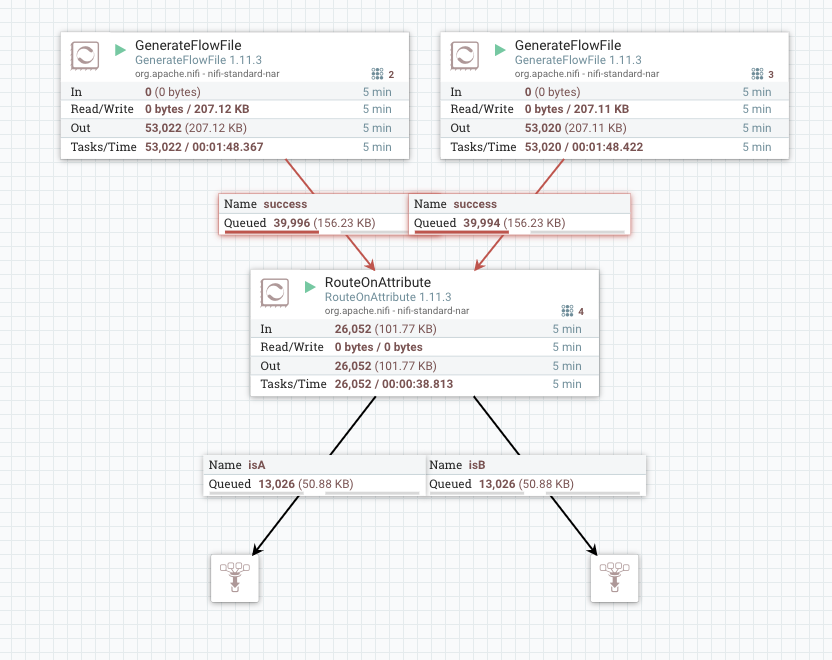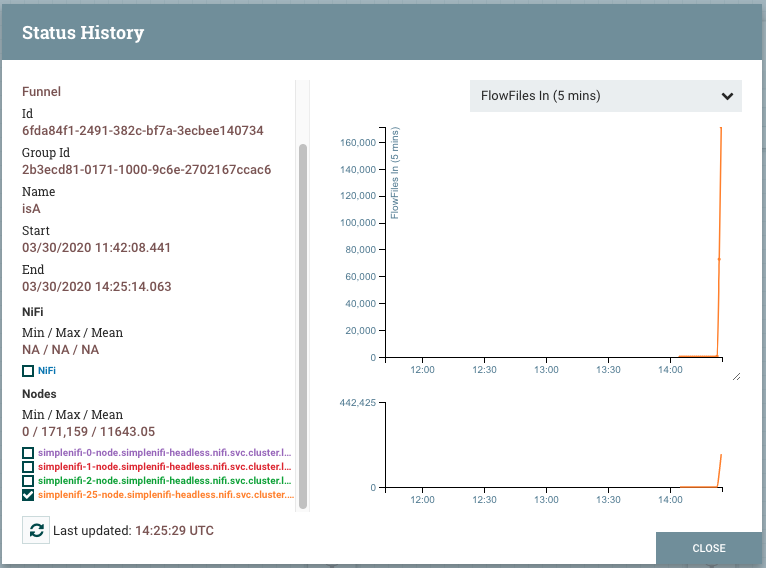Scaling mechanism
This tasks shows you how to perform a gracefull cluster scale up and scale down.
Before you begin
- Setup NiFiKop by following the instructions in the Installation guide.
- Deploy the Simple NiFi sample cluster.
- Review the Node references doc.
About this task
The Simple NiFi example consists of a three nodes NiFi cluster. A node decommission must follow a strict procedure, described in the NiFi documentation:
- Disconnect the node
- Once disconnect completes, offload the node.
- Once offload completes, delete the node.
- Once the delete request has finished, stop/remove the NiFi service on the host.
For the moment, we have implemented it as follows in the operator:
- Disconnect the node
- Once disconnect completes, offload the node.
- Once offload completes, delete the pod.
- Once the pod deletion completes, delete the node.
- Once the delete request has finished, remove the node from the NifiCluster status.
In addition, we have a regular check that ensure that all nodes have been removed.
In this task, you will first perform a scale up, in adding an new node. Then, you will remove another node that the one created, and observe the decommission's steps.
Scale up: Add a new node
For this task, we will simply add a node with the same configuration than the other ones, if you want to know more about how to add a node with an other configuration let's have a look to the Node configuration documentation page.
- Add and run a dataflow as the example:

- Add a new node to the list of
NifiCluster.Spec.Nodesfield, by following the Node object definition documentation:
apiVersion: nifi.konpyutaika.com/v1
kind: NifiCluster
metadata:
name: simplenifi
spec:
service:
headlessEnabled: true
clusterManager: zookeeper
zkAddress: "zookeepercluster-client.zookeeper:2181"
zkPath: "/simplenifi"
clusterImage: "apache/nifi:1.12.1"
oneNifiNodePerNode: false
nodeConfigGroups:
default_group:
isNode: true
storageConfigs:
- mountPath: "/opt/nifi/nifi-current/logs"
name: logs
metadata:
labels:
my-label: my-value
annotations:
my-annotation: my-value
pvcSpec:
accessModes:
- ReadWriteOnce
storageClassName: "standard"
resources:
requests:
storage: 10Gi
serviceAccountName: "default"
resourcesRequirements:
limits:
cpu: "2"
memory: 3Gi
requests:
cpu: "1"
memory: 1Gi
nodes:
- id: 0
nodeConfigGroup: "default_group"
- id: 1
nodeConfigGroup: "default_group"
- id: 2
nodeConfigGroup: "default_group"
# >>>> START: The new node
- id: 25
nodeConfigGroup: "default_group"
# <<<< END
propagateLabels: true
nifiClusterTaskSpec:
retryDurationMinutes: 10
listenersConfig:
internalListeners:
- type: "http"
name: "http"
containerPort: 8080
- type: "cluster"
name: "cluster"
containerPort: 6007
- type: "s2s"
name: "s2s"
containerPort: 10000
Note: The Node.Id field must be unique in the NifiCluster.Spec.Nodes list.
- Apply the new
NifiClusterconfiguration:
kubectl -n nifi apply -f config/samples/simplenificluster.yaml
- You should now have the following resources into kubernetes:
kubectl get pods,configmap,pvc -l nodeId=25
NAME READY STATUS RESTARTS AGE
pod/simplenifi-25-nodem5jh4 1/1 Running 0 11m
NAME DATA AGE
configmap/simplenifi-config-25 7 11m
NAME STATUS VOLUME CAPACITY ACCESS MODES STORAGECLASS AGE
persistentvolumeclaim/simplenifi-25-storagehwn24 Bound pvc-7da86076-728e-11ea-846d-42010a8400f2 10Gi RWO standard 11m
And if you go on the NiFi UI, in the cluster administration page:

- You now have data on the new node:

Scaledown: Gracefully remove node
For this task, we will simply remove a node and look at that the decommissions steps.
- Remove the node from the list of
NifiCluster.Spec.Nodesfield:
apiVersion: nifi.konpyutaika.com/v1
kind: NifiCluster
metadata:
name: simplenifi
spec:
headlessServiceEnabled: true
zkAddress: "zookeepercluster-client.zookeeper:2181"
zkPath: "/simplenifi"
clusterImage: "apache/nifi:1.11.3"
oneNifiNodePerNode: false
nodeConfigGroups:
default_group:
isNode: true
storageConfigs:
- mountPath: "/opt/nifi/nifi-current/logs"
name: logs
metadata:
labels:
my-label: my-value
annotations:
my-annotation: my-value
pvcSpec:
accessModes:
- ReadWriteOnce
storageClassName: "standard"
resources:
requests:
storage: 10Gi
serviceAccountName: "default"
resourcesRequirements:
limits:
cpu: "2"
memory: 3Gi
requests:
cpu: "1"
memory: 1Gi
nodes:
- id: 0
nodeConfigGroup: "default_group"
- id: 1
nodeConfigGroup: "default_group"
# >>>> START: node removed
# - id: 2
# nodeConfigGroup: "default_group"
# <<<< END
- id: 25
nodeConfigGroup: "default_group"
propagateLabels: true
nifiClusterTaskSpec:
retryDurationMinutes: 10
listenersConfig:
internalListeners:
- type: "http"
name: "http"
containerPort: 8080
- type: "cluster"
name: "cluster"
containerPort: 6007
- type: "s2s"
name: "s2s"
containerPort: 10000
- Apply the new
NifiClusterconfiguration:
kubectl -n nifi apply -f config/samples/simplenificluster.yaml
- You can follow the node's action step status in the
NifiCluster.Statusdescription:
kubectl describe nificluster simplenifi
...
Status:
Nodes State:
...
2:
Configuration State: ConfigInSync
Graceful Action State:
Action State: GracefulDownscaleRequired
Error Message:
...
...
The list of decommisions step and their corresponding value for the Nifi Cluster.Status.Node State.Graceful ActionState.ActionStep field is described into the Node State page
- Once the scaledown successfully performed, you should have the data offloaded on the other nodes, and the node state removed from the
NifiCluster.Status.NodesStatelist:
Keep in mind that the NifiCluster.Spec.nifiClusterTaskSpec.retryDurationMinutes should be long enough to perform the whole procedure, or you will have some rollback and retry loop.